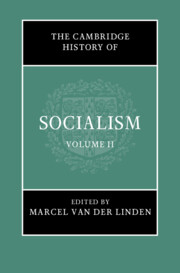Book contents
- The Cambridge History of Socialism
- The Cambridge History of Socialism
- The Cambridge History of Socialism
- Copyright page
- Contents
- Figures
- Maps
- Tables
- Contributors to Volume II
- Abbreviations
- Introduction to Volume II
- Part I Transforming State Power
- Social Democratic Routes in Europe
- Social Democratic Routes in Australia, the Americas, and Asia
- Worldwide Connections
- 12 The Second International: 1889–1914
- 13 The Second International Reconstituted: The Labour and Socialist International, 1923–1940
- 14 The Rise and Fall of the Asian Socialist Conference: 1952–1956
- 15 The Socialist International, 1951–, and the Progressive Alliance, 2013–
- 16 Municipal Socialism
- Southern Trajectories
- Left Socialisms
- Part II Transversal Perspectives
- Index
- References
12 - The Second International: 1889–1914
from Worldwide Connections
Published online by Cambridge University Press: 03 November 2022
- The Cambridge History of Socialism
- The Cambridge History of Socialism
- The Cambridge History of Socialism
- Copyright page
- Contents
- Figures
- Maps
- Tables
- Contributors to Volume II
- Abbreviations
- Introduction to Volume II
- Part I Transforming State Power
- Social Democratic Routes in Europe
- Social Democratic Routes in Australia, the Americas, and Asia
- Worldwide Connections
- 12 The Second International: 1889–1914
- 13 The Second International Reconstituted: The Labour and Socialist International, 1923–1940
- 14 The Rise and Fall of the Asian Socialist Conference: 1952–1956
- 15 The Socialist International, 1951–, and the Progressive Alliance, 2013–
- 16 Municipal Socialism
- Southern Trajectories
- Left Socialisms
- Part II Transversal Perspectives
- Index
- References
Summary
‘The Internationale/Will be the human race’. When Eugène Pottier wrote the refrain of his famous Internationale in 1871, the prospects for socialists looked rather bleak. The Paris Commune had just been crushed, and a persecuted and divided International Workingmen’s Association was already losing momentum a few years before its final collapse. But by the time Pierre Degeyter set Pottier’s words to music in 1888, a new period was underway. Just a few months later, in July 1889, the founding congress of the organization known to history as the ‘Second International’1 was held in Paris. After several abortive initiatives across the 1880s, in 1889 delegates from numerous countries met to form a new international that would rally the forces of socialism, initially within Europe alone. But there were already signs of the divisions to come: indeed, there were two competing meetings in Paris, with one (under the sway of British delegates) upholding a more gradualist perspective, and the other (centred on the German social democrats) more of a revolutionary, Marxist one. These latter soon prevailed, when a reunification congress was held in Brussels in 1891.2
- Type
- Chapter
- Information
- The Cambridge History of Socialism , pp. 278 - 299Publisher: Cambridge University PressPrint publication year: 2022

